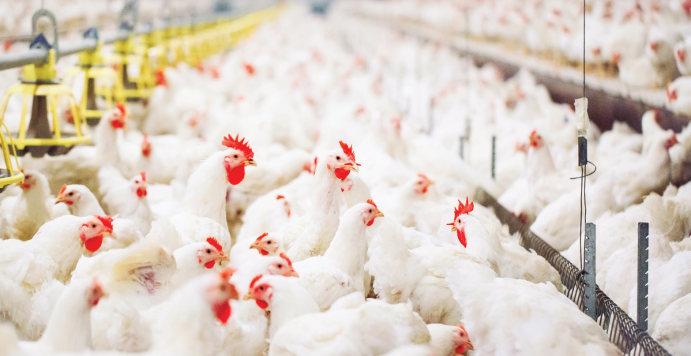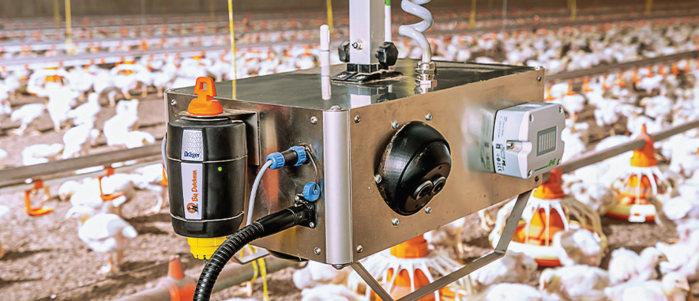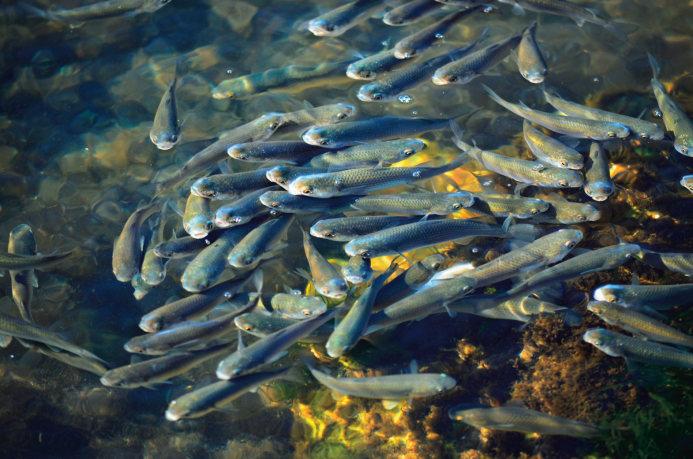
11 minute read
Taking the heat out of poultry houses
Vostermans Ventilation, the Netherlands-based ventilating equipment manufacturer, discusses how livestock farmers can determine the ideal ventilation for their poultry houses.
Equal pressure ventilation systems are becoming increasingly common in the poultry sector.
GOOD VENTILATION IS indispensable in a poultry house. With the help of mechanical ventilation and air inlets/outlets, it is possible to keep control over temperature, humidity, air speed and CO2 content in the poultry barn, while harmful substances are removed. Too little or too much ventilation results in less efficient growth of poultry, an unnecessarily high energy bill and an unhealthy barn climate for both humans and animals.
But how do you keep control of fresh air supply for an optimal stable climate? Closed versus free-range houses The easiest way to properly control the climate in a poultry house is to hermetically seal it from the outside world. Using fans, it is then possible to bring the exact right amount of fresh air into the house. Is there a need for more ventilation, for example because the temperature or CO2 content is too high? Then simply adjust the air inlets or outlets and turn on an extra fan, or make a controllable fan run faster. This way the weather outside the house has as little influence as possible on the climate inside of the house.
Lately, more and more farmers are opting for free-range houses. At the desired moments, the pop-hole doors are opened so that the chickens can walk outside freely. This of course significantly improves the animal welfare of the poultry. However, it is important that the ventilation system is adjusted accordingly. In a regular negative pressure system, false air will irrevocably be drawn in through these openings, leading to an uncontrolled house climate. Negative pressure vs equal pressure vs positive pressure An even house climate requires fresh air to be well distributed over the house. This is achieved by strategically positioning the air inlets and outlets. Fans can be placed in the air inlets (positive pressure system), in the air outlets (negative pressure system) or both (equal pressure system).
Negative pressure system Negative pressure systems are by far the most common in poultry houses. When using negative pressure ventilation, air is sucked out of the house with the help of exhaust fans. Because there is negative pressure relative to the air pressure outside, fresh air flows into the house through air intakes. By adjusting these air intakes to the amount of air that is extracted from the house, it is possible to control the incoming air flow. The position of the air inlets allows you to control the angle and the speed of the air that is entering the house. A negative pressure system is not suitable for use in free-range houses.
Equal pressure system Equal pressure ventilation systems are becoming increasingly common in the poultry sector. Using an equal pressure system, both exhaust and intake fans are used, and the air pressure in the house is kept equal to the air pressure outside the house. The fans become slightly more economical because they do not have to build up any pressure, however, twice as many fans are required. The advantage of an equal air pressure is that the indoor climate is not disturbed when a door is opened somewhere. This makes equal pressure systems very suitable for freerange houses.
Positive pressure system Poultry houses with a positive pressure ventilation system are rare in practice. In a house with positive pressure, fresh air is blown in with the help of fans and extracted in a controlled manner using air outlets. This increases the pressure in the house relative to the outside pressure. It will cause air to try to escape from every crack in the house. Insects, and therefore diseases, are less likely to enter the house. It is a principle that is also being used in hospitals and laboratories, for example. If a door is opened somewhere, air will flow out through this door. This makes a positive pressure system suitable for free-range houses. In practice, it is common to see free-range houses being equipped with both a negative and a positive pressure system. ■
If you would like to know more about the different ventilation systems or about common mistakes in poultry houses, visit Vostermans Ventilation B.V.
Keeping track of flock health in the broiler house

WHY IS THE current flock performing so much better than the previous one? Why is the litter in the rear right corner always the first to get wet? Even with years of experience, it is not easy for broiler producers to answer these and similar questions.
The reason is quite simple: it is difficult to collect the necessary data 24 hours a day, seven days a week, and basically in three dimensions – and it is even more difficult to analyse them. Big Dutchman offers a solution to this problem: ChickenBoy is an analysis robot for permanent bird monitoring and measuring of climate parameters in broiler houses.
Equipped with different sensors and several cameras, ChickenBoy is suspended from a rail system under the ceiling and keeps track of what is going on in the barn. A powerful processing unit analyses the data, partially with complex AI algorithms, and prepares a graphical representation for the customer.
“We want to provide the farmer with an adequate digital cockpit that shows information about the broiler house in a clear and easy-to-understand manner,” said Dr Heiner Lehr, CEO of Faromatics, the robot’s manufacturer.
The added value for the customer is obvious. The cockpit comprises multiple two-dimensional maps of the barn that visualise, for example, the current air quality very exactly, based on values such as temperature, air speed, humidity and the concentration of harmful gases (CO2 and NH3). The measured data can also be viewed in diagrams that indicate the progress of the batch.
Broiler production: intelligent image evaluation The greatest strength of ChickenBoy is its intelligent image evaluation. For example, the robot finds dead birds and leaking
ChickenBoy
nipple drinkers. Through a deep-learning functionality, it is able to discover the spread of possible intestinal diseases in the flock early on, based on permanent excrement rating. To complete its bundle of features, the robot provides images as well as audio and video tracks of the current situation in the barn.
“With ChickenBoy, digitisation has now truly found its way into broiler houses,” said Christian Woltering, Big Dutchman sales manager for broiler production in Germany.
“Across the board, the customers who installed the first robots during a pilot phase were very happy with the system. All of them were able to use the collected data to further optimise their production regarding climate and bird health,” he concluded. ■

Phage technology: The future of health management in aquaculture
Products made with bactriophage technology are a safer, more sustainable solution for eliminating disease causing bacteria from fish farms.
GLOBAL FISH consumption has increased at an average annual rate of 3.1% from 1961 to 2017, at almost twice the rate of annual world population growth in the same period.
Despite differences in levels of fish consumption between developed and developing countries, there has been a steady rise in fish consumption worldwide.
With the global fish consumption steadily on the rise, aquaculture is the fastest growing food sector in the world (FAO). But the industry is not without its challenges such as several diseases causing bacterias and viruses, which lead to huge economic losses and wastage of fish. Since the problem of antibiotic resistance is looming large already, it becomes imperative to look for alternative solutions to keep the fish and the eco system healthy, while reducing the toxicity of fish farm water due to drug overuse.
Poland-based biotech company, Proteon Pharmaceuticals and Norway-based aqua feed company Skretting, have come up with a solution to tackle health challenges facing the aquaculture industry. The companies have entered into a partnership to develop products using bacteriophage technology, which will help eliminate disease causing bacteria in fish farms and support aquaculture farmers.
Bacteriophages (first discovered by Frederick W. Twort in Great Britain in 1915, and by Félix d'Hérelle in France in 1917) are commonly found substances in the eco system, which feed on specific types of bacteria. Phages have a unique way of acting only on a certain target specific bacteria, leaving the rest of microbiome intact.
Proteon Pharmaceuticals intends to harness this trait and arrive at a controlled delivery of phages, through the use of precision biological tools; to eliminate disease causing bacteria and reduce antibiotic usage, as well as increase sustainability in aqua and agriculture.
But this is not the first time that Proteon Pharmaceuticals has attempted to create products which target specific bacteria. The biotech company has been developing phage-based products for the past 10 years now and has launched products, such as BAFASAL and BAFADOR, in the recent past.
While BAFASAL is a feed additive that eliminates salmonella infection in poultry, BAFADOR is a bacteriophage cocktail that prevents and eliminates Pseudomonas and Aeromonas infections in commercial aquaculture and activates the immune system of fishes.
The initial phases of the project consist of isolating the most prevalent strains of Vibrio, that will be carried out by Skretting; while Proteon will determine the complementary groups of phages which act upon them. Skretting Aquaculture Research Centre (ARC) researchers will test the efficacy of the phages during the challenge trials. The project is scheduled to be completed in four to five years.
There are others, who have tried and tested the phage technology and its uses in eliminating diseases in fish and poultry.
Glasgow-based STIM got the approval to create a bacteriophage product, back in 2018, which helps eliminate Yersiniosis in bio filters, well boats and production water.
The product, CUSTUSYRS, contains five hundred thousand billion Yersinia-killing phages per litre which, if administered in high density to production water or biofilters, reduces the infection pressure quickly and also prevents the further spread of bacteria to the healthy fishes.
STIM has also identified EMS causing Vibrio bacteria and is presently conducting trails with the EMS phages in Vietnam, in collaboration with the Norwegian and Vietnamese scientists.
In addition, Fixed Phage Technology has been known to coat shrimp feed in phages which can kill EMS causing bacteria. They are still in the process of conducting field trials whereby feeds coated with an aquaPHIX solution have shown significantly improved outcomes in shrimps. Recently, a Scottish Enterprise has also pledged an investment of US$3.2mn to support Fixed Phage’s projects of developing natural antimicrobials that could help improve human and animal health. ■

According to FAO, aquaculture is the fastest growing food sector in the world.
Automated tractors support economical farming
Remote and automated tractors can make processes such as tillage more efficient and cost effective.
IN JAPAN, THE agricultural landscape is radically changing. In 2016 the farming population dipped below two million for the first time and has continued to decrease; the number of family-owned farmsteads are declining; the average age of farmers is increasing and the process of consolidating land into smaller holdings is accelerating.
For those left in the agricultural industry, work must still press on, and a growing number of farmers in Japan are reaping the benefits of digital and automated technology, to cope with the shortage of labour and conduct fundamental process such as tillage and cultivation.
Steering this trend, a number of machine manufacturers have been releasing automated vehicles such as tractors to enable farmers to remotely conduct and track their work.

Yanmar Agribusiness Yanmar Agribusiness have announced that from 1 April 2021, they will be making new upgrades to their autonomous tractor series commercially available.
The new range includes a number of features to make the tractor more adept at carrying out a range of agricultural activities including multi-frequency antenna for faster positioning (75% reduction) and safety even if the signal is interrupted on one of the signals; Virtual Reference Station allowing the tractor to receive local reference point position data to determine its position nullifying the need for a Yanmar base station; lower speed allowing more precise work to be carried out so that previously inaccessible tasks such as combined tilling and ridging can now be carried out by the robot tractor. Nagamori Masuda, president of Yanmar Agribusiness, commented, “Yanmar’s auto tractor and robot tractor have found favour in the farming community for their efficiency, reliability and accuracy. With these new models, Yanmar offers farmers even more value with more robust positioning technology that allows even greater flexibility in the field.” Kubota Kubota have also made it their mission to help the farmers through smart agriculture. Since the launch of their automated rice planter in 2016, the company has been expanding its autonomous range to include a combine harvester and tractors for a range of different agricultural activities.
Kubota’s AgriRobo is the company’s agricultural machinery which is capable of unmanned, automatic operation. Through remote control instructions farmers are able to completely control the tractor as it carries out activities while its advanced GPS and automatic driving technology can perform activities such as cultivating and puddling at a high degree of accuracy. ■






